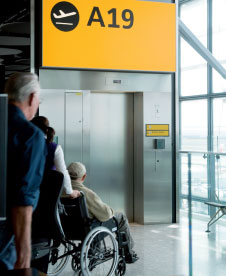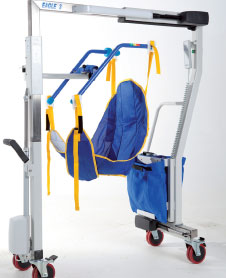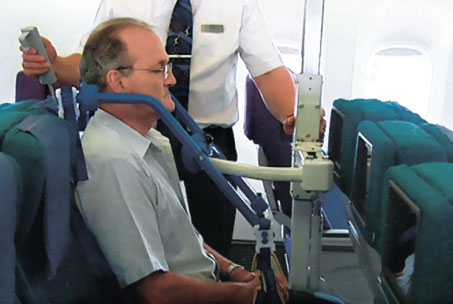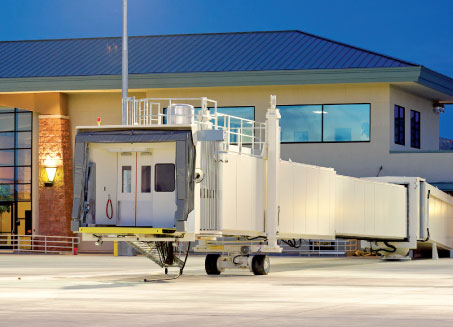
Dufresne: “The goal of the interpretation guidelines is to improve the journey for 80 million Europeans with disabilities and the European institutions should keep focus on this objective.”
It is widely accepted that the adoption of Regulation 1107/2006 – under which airport managing bodies are responsible for the assistance on the ground – has led to improvements in the travel experience for PRMs.
In January this year, the service level offered to PRMs hit the news when a French court found easyJet guilty of discriminating against disabled passengers in three separate cases in 2008 and 2009. According to Guillaume Dufresne, Mobility and Transport Officer, European Disability Forum (EDF), this “represented an important landmark since the case was won by referring to Regulation 1107/2006”.
The European Commission now plans to publish ‘Interpretative Guidelines on the application of Regulation 1107/2006’, but Dufresne explained that the EDF has some concerns. “As currently worded, the guidelines might broaden the scope of the Regulation and extend the category of passenger protected by the Regulation,” he said. “The Commission must realise that this extension will not benefit the beneficiaries of the Regulation; it will create considerable operational difficulties for various parts of the aviation industry, and will be detrimental for persons with disabilities who would no longer be able to receive appropriate assistance.

At London-Heathrow Airport, BAA and Omniserv are currently working on introducing a new product called the ‘Eagle’, which has been developed by Haycomp.
“The goal of these interpretation guidelines is to improve the journey for 80 million Europeans with disabilities and the European institutions should keep focus on this objective. EDF believes this is the only way the guidelines will bring results.”
For its part, ACI EUROPE notes that since the entry into force of the Regulation, European airports have reported a steady growth in assistance requests. The aim of the interpretative guidelines should be to clarify and unequivocally define PRMs. The proposed guidelines appear to considerably broaden the range of passengers categorised as PRM, rather than attempting to clearly define it. This will – without any doubt – lead to a considerable increase in the usage of the services and to the potential for further abuse, increased costs of facilitating passengers who would have traditionally negotiated airports without seeking additional assistance. Moreover, this broadening would be to the detriment of real disabled persons and PRMs.
While sharing the European Commission’s views that assistance should be provided without undue restrictions, ACI EUROPE believes that the legislator’s aim has been to protect real disabled persons and PRMs against discrimination and ensure that they receive assistance when travelling by air.
The inclusion of other categories of passengers under the scope of the Regulation will not only result in reducing the quality of the service offered to truly disabled persons and PRMs, it will also have effects on the infrastructure created to provide the assistance that could become insufficient if the number of assistances were to increase significantly.
ACI EUROPE believes that age, obesity and pregnancy “per se” are not a cause of disability. Therefore, in ACI EUROPE’s opinion, and exceptionally, only when mobility is affected, they could be considered as falling under the scope of the Regulation. Unaccompanied minors will under no circumstances be covered by the terms of the Regulation.
Making progress
Since the PRM rules came in, European airports of all sizes have taken steps to ensure that adequate facilities are in place to cater for PRMs and the technology available continues to evolve. At London-Heathrow Airport, for instance, BAA and Omniserv are currently working on introducing a new product called the ‘Eagle’, which has been developed by Haycomp.
“The EU rulings have made an improvement to the travel experience of many PRMs,” said William Hay, Market Development Consultant, Haycomp. “Defining the responsibilities of the airlines and airports has made matters clearer.” While he explained that suggested changes to the resolution of complaints would allow for further improvement, he also said that “there still appears to be differences in the attitude of some airlines to the rulings”.
One key point, he said, is that airlines still need to do more to make air travel accessible to quadriplegic passengers. Although airports have already made moves to install disabled parking, disabled toilets, and ramps, now steps need to be taken to ensure that the same happens with regard to access to the aircraft.
Innovative solution

The European Commission will soon publish ‘Guidelines for Regulation 1107/2006’, which will be aimed at further improving the level of service offered to passengers with reduced mobility.
Haycomp has first-hand experience of working with airlines and airports to improve PRM services and having developed the Eagle hoist following consultation with Qantas, Air New Zealand and Air Canada also now utilise Eagles, while WestJet will soon adopt them.
The contract at London-Heathrow is significant as it is the first major airport in Europe to make use of the Eagle. “We also have strong interest and trials currently ongoing at Paris Charles de Gaulle Airport,” Hay said. One of the main benefits of the product, he outlined, is that the Eagle only ever needs two operators at any time, therefore reducing any issues concerning resources. It also eliminates the risk of poor manual handling, which can deter PRMs from flying.
While the development of innovative solutions such as the Eagle hoist and the frequent review of the relevant legislation helps to ensure that progress is being made, Hay said that there is still room for improvement within the industry. Supporting the findings of the recent review, he said: “There is still work to do on the issues of handling full assistance PRMs. There is a case for working with ACI EUROPE, IATA and other stakeholders to define the needs of these special passengers, so the service providers know what equipment, staff and seating is required to board them and equally importantly, that they get accurate and timely information about PRMs on incoming flights.”
Following its own study into the effectiveness of the current PRM regulation and full consultation with stakeholders, the European Commission is due to publish its interpretative guidelines regarding services to PRMs before the summer.
JBT’s ground support and gate equipment
JBT AeroTech, Jetway Systems, is a global leader in the design and manufacture of cutting edge ground support equipment and airport gate equipment, featuring Jetway passenger boarding bridges, JetPower 400 Hz ground power units, JetAire preconditioned air units, JetFlo potable water cabinets, BagBuddy luggage lift, Apron Management Systems (a management tool for asset management, maintenance and billing), and many more products and services.
Jetway Systems offers customised solutions for air transportation with the lowest life cycle costs possible. Jetway Systems provides seamless integration of the passenger boarding bridge, preconditioned air unit, ground power unit, and other systems and equipment, thereby reducing aircraft turn times.
As a single-source supplier with unparalleled product range, Jetway Systems simplifies procurement, contracting, project management, sourcing parts, and securing qualified technical support for trouble free airport operations.
Jetway Systems’ objective has been to reduce maintenance requirements and increase functionality while providing a safe, efficient, and reliable means to board and service the aircraft. For more than 50 years, JBT AeroTech, Jetway Systems, has been relied on to provide gate related products and services.

JBT AeroTech, Jetway Systems, offers a range of ground support equipment and airport gate equipment, including Jetway passenger boarding bridges, JetPower 400 Hz ground power units, and JetAire preconditioned air units.







